Sault Ste Marie has a number of well known hiking and fall-colour viewing areas in or around the city, including Robertson Cliffs, Fort Creek and Bellevue Park, but not everyone will be aware of these four relatively hidden spots.
So keep reading to learn about four of the best ‘other’ places to explore and to enjoy the fall colours from.
The Odena lookout and Odena Loop at Hiawatha Highlands is part of the Voyageur Trail. The large ‘Loop’ trail is a 4.2km hike that starts at Sixth Line and weaves itself over to Connor Road. Alternatively if you just want to enjoy the incredible view, the Lookout hike is a short 400 metre trot uphill. Once you get to the top the view will take your breath away. Beautiful maple fall colours blended with vibrant coniferous greens make this lookout truly spectacular.
Wishart Park, just off Fourth Line East, is a cute little park, and a perfect place for a short hike to take fall fall photos in. Enjoy a walk through the woods or alongside the Root River as it winds its way south towards the city.
Root River and Root Cascade at the west side of Sixth Line is another pretty place to visit. Beautiful falls cascade into the Root River, and the surrounding maple trees create a vibrant and bright scene.
The lookout at Gros Cap Conversation area is another great spot just outside the city limits. While the tree species here don’t offer the vibrant red and oranges of Hiawatha, you can still enjoy fall tones with incredible views of the place where Lake Superior flows into the St Marys river, the Gros Cap lighthouse, and any Lake Superior ‘lakers’ that happen to be cruising past.
The lookout is part of the Saulteaux-Goulais section of the Voyageur Trail, which leads west and north towards Red Rock.
The world-famous Snowbirds, the Canadian Forces esteemed air demonstration team, are heading to Sault Ste. Marie, Ontario on Saturday, September 21st, and the Canadian Bushplane Heritage Centre is making a day of it!
Bushplane Days, the annual 2-day celebration, is hosting a pre and post-show featuring Snowbird-themed entertainment, plus there will be a designated waterfront viewing area, so you can get front row seats to one of the most anticipated shows in Sault Ste. Marie!
In addition, you can experience the thrill of flying in the Snowbirds yourself via a new virtual reality simulator provided by VSB Foundation, which will be situated in the Bushplane Museum all day Saturday and Sunday.
Finally, stick around after the show when the pilots will be back in town for an exclusive meet-and-greet at the Canadian Bushplane Heritage Centre from 4.30-6pm.
The Snowbirds are the Canadian Forces esteemed air demonstration team and have been operating since the 1970s. They typically fly in formations of 9 aircraft with manoeuvres designed each season and approved by the Canadian Forces. The Snowbirds fly the Canadair CT-114 Tutor, a Canadian-built jet that was used by the Canadian Forces until 2000. The Tutor weighs approximately 7,170 lbs (3,260 kg) and is powered by a J-85 engine producing 2,700 pounds of thrust. Top speeds of the aircraft during the displays range from 100 to 320 knots or 185 to 590 km/h, and the planes fly as close as 1.2 metres to each other!
The airshow is scheduled to begin at 2pm and will be visible along the Sault Ste. Marie waterfront. The show is designated as a non-aerobatic display. Feel the rumble and immerse yourself in the thrill as the Snowbirds soar and swoop just 500 feet overhead, delivering an unforgettable airshow above the St. Marys River. The show is anticipated to be approximately 30 minutes overhead and will be accompanied by music and live commentary.
The Snowbird Boss (Lead Pilot) is Major Brent Handy, a graduate of Sault College’s aviation program. Major Handy succeeded into the role in of Snowbird 1 for the 2024 season and attended Sault College from 1996 to 1999. In addition, a second pilot flying Snowbird 9 Captain Patrice Powis-Clement, grew up on nearby St. Joseph Island and also graduated from Sault College’s Aviation Technology Flight program.
Day 1 of Bushplane Days is dedicated to celebrating aviation history, including the 100th Anniversary of the Canadian Airforce with the Snowbirds airshow. Activities throughout the day will be Snowbird-themed. Doors open at 10am with a variety of family-friendly activities including facepainting, crafts and fun with Entomica creatures.
New this year is the addition of a digital technology company VSB Foundation, who will be offering the very latest virtual reality flight simulator experience. Find out what it feels like to fly with the Snowbirds with this new, fully immersive experience that leverages the latest cutting-edge technology. The VR simulator, will put you in the (virtual) seat of a Snowbird aircraft and will be available at no additional cost, on a first-come, first-served basis during the day.
At lunch time enjoy food from the BBQ, listen to live music and enjoy a specially brewed ‘Tipsy Beaver’ beer by Northern Superior.
Then, at 2pm, witness the specular aerial display of the world-famous Snowbirds in a designated, waterfront viewing area on the apron of the Bushplane Museum. Limited seating will be available.
The entertainment continues after the show with more live music, food and drink. At around 4.30pm, you can get a chance to meet the Snowbirds pilots as they head back to the city for an exclusive meet-and-greet at the Canadian Bushplane Heritage Centre.
Check out the festival schedule below! Admission is by donation but a $10 donation will get you free ice cream or lemonade!
Saturday
10am-6pm
Sunday
10am-4pm
On Friday, September 20th, the day before the Snowbirds show over Sault Ste. Marie’s waterfront, there is a ticketed VIP meet and greet event happening at the Sault Ste. Marie airport.
An excursion from the Bushplane Museum to the airport will leave at 10.30am. Get all the information here plus tickets here.
With the airshow spanning the waterfront the best viewing locations will be from the Sault Ste. Marie Canal National Historic Site all the way down to Bellevue Park.
Clergue Park will host the Snowbird’s very own commentator stage. This commentary of the aerial display is a key feature of the Snowbirds routine and will be broadcast on a local FM radio station (to be confirmed closer to the time) so viewers can hear the show from all locations.
The Roberta Bonda Pavilion will also be a great spot to view the Snowbirds and the Miss Marie is running a special Snowbirds tour that day.
For a truly unique experience, board the Miss Marie Lock Tour boat for a special Snowbird themed charter on the water, directly below the airshow. Departing at 1pm and returning at 3pm guests can enjoy a river cruise and airshow for $60 per person. Limited tickets available. Appetizers will be served and the charter is fully licensed.
Visit www.saultlocktours.ca for more information.
A map of downtown car parking areas is available by clicking here.
Come down to the Bushplane Museum on Sunday where the fun continues. This year is the 100th anniversary of OPAS (Ontario Provincial Air Service) and there will be celebrations to honor this achievement. More details and exciting announcements to come!
Get more details here.
Admission is by donation. All funds raised support the Bushplane Museum’s programs, exhibits and services.
For more information about the Bushplane Museum (Canadian Bushplane Heritage Centre) and Entomica, click the below links.
Thanks to the Sault Ste. Marie Airport, for hosting the Snowbirds, as well as providing logistical and technical support. “As the private owner and operator of the Sault Ste. Marie Airport, we see this as a gesture of support for our community and an opportunity to spark interest in aviation across all age groups. This event aligns perfectly with milestones in aviation history, making it especially meaningful for us.” Terry Bos, President and CEO of the Sault Ste. Marie Airport Development Corporation.
Sault Ste. Marie is the perfect place to spend some time together as a family. Also referred to as Bawating, meaning “place of the rapids”, the area is rich in Indigenous culture and history. From the whir of excitement at a local powwow to the somber history of the residential school system, there is so much for you to learn and experience together in Sault Ste. Marie.
Here are 7 ways you can experience Indigenous culture in the Soo:
Whether you’ve been to a powwow before or want to experience one for the first time, you will love the Learn to Powwow Tour with Thrive Tours. Your tour guides will start you off with an introduction, covering powwow history and etiquette, and explain how you can engage in the celebration as a non-Indigenous person. You will also learn the significance of the music and about the different kinds of dances. After your powwow intro, you will join your guides for the spectacular Grand Entry where you’ll watch the dancers enter the circle in their regalia and listen as the drummers echo the heartbeat of Mother Earth. To complete your experience, make sure to try some food, explore the vendors and maybe even join in during an intertribal dance!
As you make your way through the buildings and streets of Sault Ste. Marie, you will notice the many large murals painted throughout the city. Many of the murals you’ll find here have been painted by local Indigenous artists. This display of artwork adds a splash of color and vibrancy to the city that everyone in the family will enjoy! Each June, during the Summer Moon Festival, you can watch new murals being painted around the Soo and experience many other Indigenous arts & culture workshops, exhibits and performances.
Grab your bikes or walking shoes and spend some time exploring the Indigenous history of Whitefish Island. Whitefish Island is a territory of the Batchewana First Nation and a National Historic Site of Canada. Plaques located around the island provide information about the history and significance of the area, dating back hundreds of years. Once home to many, Whitefish Island was a significant site for fishing and trading throughout history. Now, the island is a popular birding location and the well-maintained trails and boardwalks allow visitors to easily access and enjoy nature.
Get out on the river in a kayak or canoe with Thrive Tours. Your adventure begins with acknowledging the history of the land and showing respect to the water by saying “Miigwetch”, which means “thank you”. Next, you will receive instruction on paddling and water safety before getting in your boat and setting off on the river. Boats, paddles and life jackets are available for both adults and children. While on the water, you will learn about the history of the area and you may even be treated to a traditional song sung by your tour guide.
Canoes for Conservation also offer interpretive tours of the St Marys river in their popular ‘big canoe’. Dip your paddle into the famous Whitefish Rapids at Bawating, one of the most significant cultural gathering places of the Anishinaabe People since time immemorial. These tours are popular with groups and families and expert guides provide a rich description of the area.
The Shingwauk Residential School in Sault Ste. Marie was operational from 1875 until 1970. Join Thrive Tours to see the residential school grounds and buildings, now part of the Algoma University campus, and learn about the residential school system. You will hear about the devastation the system had on the Indigenous people in the not-so-distant past and the inter-generational trauma affecting communities and families today. If you are touring with kids, information is shared in a truthful yet age-appropriate way. Learn about what is being done for healing and restoration and what you can do in this process as an ally.
Take a beautiful drive along the Trans Canada Highway to see the Agawa Rock Pictographs in Lake Superior Provincial Park. Located about 1 hour North of Sault Ste. Marie, this 0.5km loop trail will take you right along the shore of Lake Superior to the Indigenous archaeological site where you can see sacred Ojibwe paintings dating back to the 17th and 18th centuries. The hike is rated as moderate, but some scrambling over rocks is required. To see the pictographs, you’ll need to walk out on a sloped rock shelf beside the lake. The views are definitely worth it, but please take caution as the rocks can be slippery!
After working up an appetite during your Sault Ste. Marie adventures, stop by Chummy’s Grill for a delicious meal. This local Indigenous-owned and operated family restaurant has a wide variety of delicious food available. The restaurant has a great kids menu and even has all-day breakfast (except Friday 4-8pm). While here, make sure you spend some time admiring the wood carvings located throughout the restaurant.
Now it’s time to get your family and come explore Bawating! With so many different ways to experience Indigenous culture in the Soo, you’ll want to keep coming back for more.
And read our blog post from summer 2021 about spending a day with the family in Sault Ste. Marie here!
Once a key industrial part of Sault Ste. Marie, the Canal District has been reimagined, restored and rebuilt to be one of Northern Ontario’s premier destinations for dining, entertainment and tourist attractions.
A new train station for the Agawa Canyon Tour Train, built in a style that compliments the historic surrounding buildings, is just one of exciting developments to have happened that has revitalized a key area of the city. There is also a microbrewery, four restaurants, a gelato mill, an outdoor adventure store complete with indoor climbing wall, an exhibit centre-gallery, an outdoor event centre and a rink!
Keep reading to find out more about this exciting destination in the city.
The Machine Shop boasts three magnificent restaurants as well as a top notch win bar.
The Mill Steakhouse + Wine Bar is fine dining at its best; 45 day aged AAA Ribeyes, 16oz New York Striploin, Prime Rib and all with fresh ingredients, in an elegant setting with superb service and friendly atmosphere.
The Boiler Room is an easy, family-friendly pizzeria, offering freshly prepared wood-oven pizza in a relaxed steampunk style restaurant. Next door to the Boiler Room is a The Steamfitters Lounge; a unique space where you can enjoy the wood-fired pizza menu that is also available for private functions of up to 60 guests.
The Blockhouse Pub offers great pub-grub, large portions and a full array of beer including locally brewed Outspoken, which is brewed on site. Stop for all day breakfast or come in for a grab and go panini from their delicious deli!
The Gelato Mill offers fresh Starbucks coffee, lots of snack options including freshly made pastries and of course a variety of gelatos.
Create your own ice cream sandwich, indulge in a slushy, or stop by for a delicious treat and fresh cup of joe.
The Outfitters is located inside the new train station building. It offers a wide variety of outdoor equipment and top brand clothing and accessories for your entire family – gear and clothing for adults & kids! You can climb our indoor rock wall or shop for a canoe, kayak or paddle board. Enjoy the amazing art by Indigenous artists Tomas Sinclair and John Laford.
A prominent feature of the Canal District is the newly build train station for the Agawa Canyon Tour Train. The station is open and tickets can be purchased while the train is running during the summer and fall months.
The Rink is a covered outdoor skating rink that is available for hire or for public skates during the winter months. During the summer the rink turns into an events space (see below for more info on that). Check out the Rink’s website here for all the information you’ll need on using the ice!
The Canal District hosts events throughout the year from live music and comedy through to beerfest events, Christmas events and summer outdoor car shows and outdoor roadshows. Check out out the latest events here!
The Mill Market Farmers Market is conveniently located just steps away from Canal District and Machine Shop. Grown, raised or crafted by Northern Ontario’s farmers, ranchers, fishermen, artists and artisans; Mill Market brings the best of our lakes, fields and forests to the heart of the historic Canal District in downtown Sault Ste. Marie. From farm to table,
The Mill Market is open Saturdays year-round 9am – 2pm, and Wednesdays 11:30am – 2pm (June 29th through September 7th, 2022). Visit this website for more information!
Just a short walk or bike ride away from the Machine Shop and train station is the actual Sault Ste. Marie Canal National Historic site.
The Canal, built in 1895, was the world’s longest lock, the first to operate using electricity and the last link in an all-Canadian navigational chain from the Atlantic Ocean to Lake Superior. Today, the Canal is a great spot for boat-watching, picnics and a variety of other activities. Let a Parks Canada interpreter introduce you to the canal’s fascinating history, rent a Fat Bike, check out the new visitor centre.
For more information on the Canal District visit this website!
Where Fort Creek enters the St. Marys River just below the historic locks at Sault Ste. Marie Canal National Historic Site, it’s a shallow channel scarcely broad enough to turn a canoe around. Bridged by boulevards and hemmed by sidewalks and parking lots, the creek disappears altogether for much of its course, buried and nearly forgotten beneath the city above.
On a warm spring evening, I witness a very different Fort Creek, winding through a verdant wetland filled with the sunset songs of veery, Swainson’s thrush and ovenbirds. A contented beaver navigates the meanders, watchful Canada Geese periscope from grassy banks. Perched above downtown, Fort Creek Conservation Area is a remarkable green space within the city.
The way Lake Superior Watershed Conservancy Executive Director, Joanie McGuffin, explains it, Fort Creek is both a living waterway and an allegory for the unseen connections that bind past to present, and culture to ecology.
Revealing hidden connections—between rivers, lakes, watersheds, communities, cultures, people and the planet—is the focus of a new visitor experience developed by the Lake Superior Watershed Conservancy in partnership with the Huron-Superior Regional Metis Community.
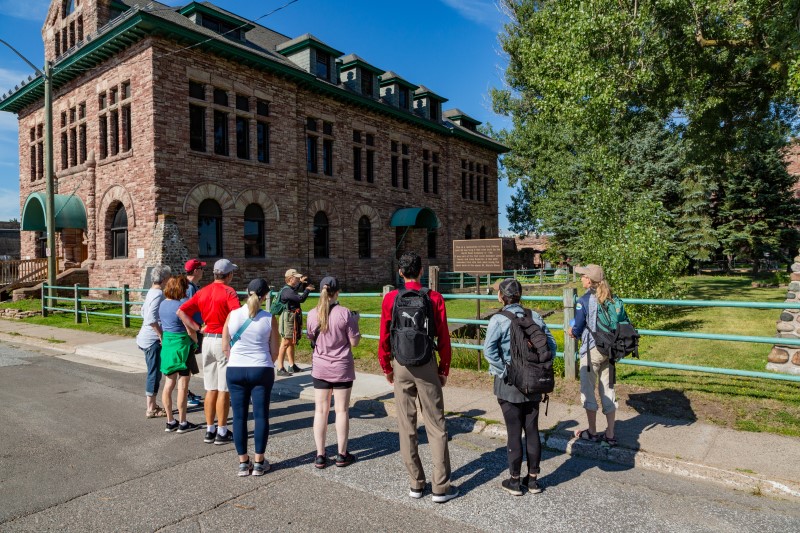
These interpretive tours provide visitors to Sault Ste. Marie with an exciting new way to discover the city, while making meaningful connections to the Soo’s vibrant Indigenous culture and heritage. Historic images, maps and hands-on materials add texture and context, transforming a modern cityscape into an historic gathering place, and an industrialized urban waterfront into a richly interconnected ecosystem.
For generations, the land that is now downtown Sault Ste. Marie was home to a thriving Métis community. The community was organized into river-lots that gave each family access to the river for travel, harvesting and economic activity. Families kept their animals communally in the area behind their homes and harvested maple sugar in spring along the escarpment. In the mid 1850s, Métis families were displaced from their lands, breaking promises by the Crown agent that their lands would be protected. Despite this injustice, the community continues to call Sault Ste. Marie home.
By sharing Métis perspectives on reciprocity and sustainable practices, the interpretive tours also advance the Lake Superior Watershed Conservancy’s work to promote watershed awareness and greater environmental understanding.
“The Métis story inextricably connects culture with ecology,” says McGuffin. “Indigenous people have been able to live with the land and care for our water for thousands of years, because it’s been a reciprocal relationship.”
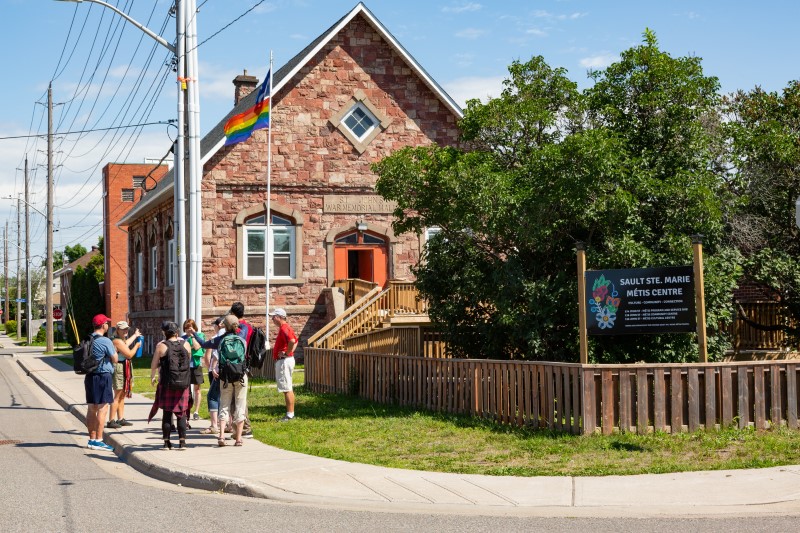
Tour participants can choose to join a Walking Tour or get on the water with a Walking & Paddling Tour. Both tours travel to the city’s scenic waterfront from the Sault Ste. Marie Métis Cultural Centre—a first of its kind in Ontario. Tours last two hours and are led by a Métis interpretive guide, giving visitors a fascinating glimpse into traditional and contemporary Métis life.
Paddling Tour participants board a Big Canoe—a replica of the 36-foot birch-bark canoes that once freighted furs and trade goods between Montreal and Lake Superior—to learn how the St. Marys River is central to both the story of Sault Ste. Marie, and the Indigenous communities who live here.
McGuffin believes passionately in the power of the Big Canoe to bring people together to share ideas and cultural understanding. In 2019, the Conservancy founded a new program called Canoes for Conservation, and she points to the Big Canoe’s stability, inclusivity and accessibility for non-paddlers and multi-generational groups of all ages.
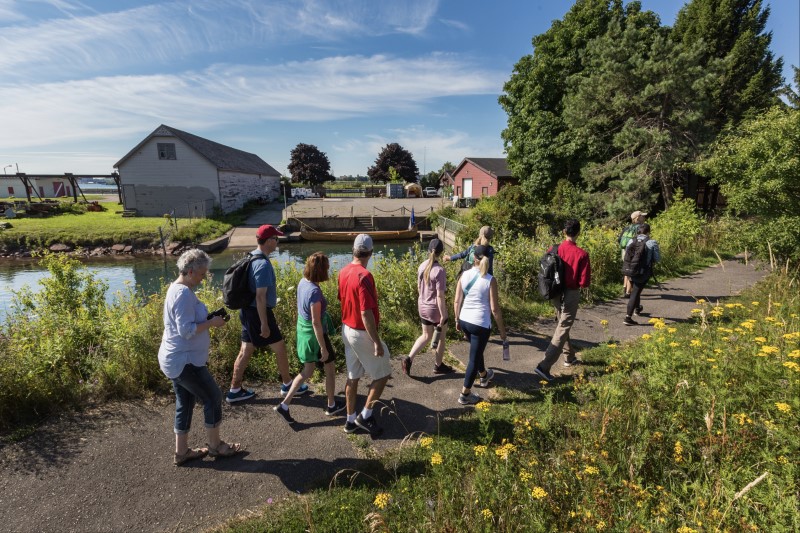
A highlight of the hour-long canoe portion of the journey is “locking through” the historic Sault Canal. Paddlers then venture onto the mighty St. Marys River—comparable in size and power to the Niagara River—feeling the spray of the rapids and the tug of the current beneath their hull. “It’s very tactile,” says McGuffin, “you have a paddle in your hands, you’re able to feel the water, listen to the water. It’s incredible how far into the rapids you can go—people are amazed by the experience.”
For the Métis Nation of Ontario, the tours are “an outstanding opportunity to grow Indigenous tourism in the north and advance reconciliation,” says community leader, historian and MNO Huron-Superior Regional Councillor, Mitch Case.
“In order to have that reconciliation conversation, Canadians need to understand who we are and what matters to us as a community,” he continues. By connecting across cultures, “we are protecting and preserving our unique heritage and world view.”
Lauren Towell is one of five young Métis community members who joined the interpretive guide team this summer. “The connections I share with the water resonate profoundly with the very fabric of my Métis heritage,” she says. “I take great pride in the task of sharing our story, ensuring that it endures for generations to come.”
Walking tour guide, Jake Chalmers, agrees, “Caring for our forests and wildlife is integral to caring for our Métis culture. Being a tour guide helps me to celebrate and share knowledge about both.”
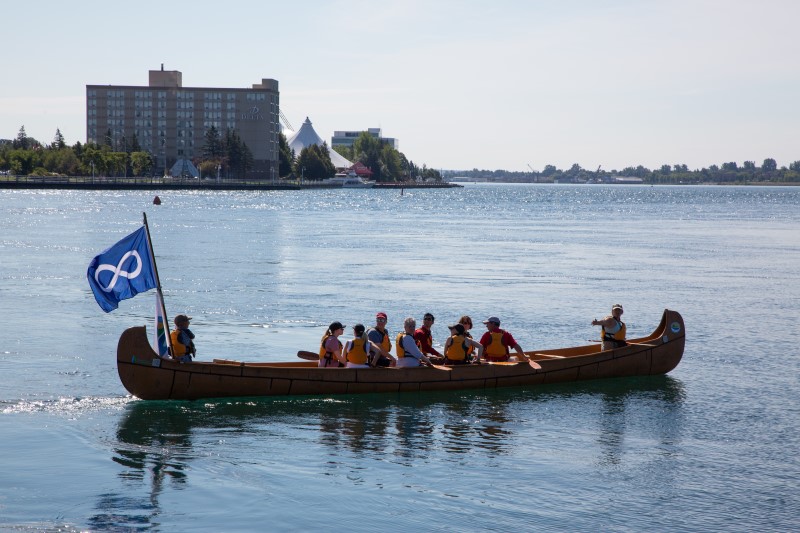
The tours visit numerous sites of great importance to the Métis community. In just a couple short hours, participants come to understand how connection to the river and love for their ancestors empowers the Métis community here—and what it can teach all of us.
For those visiting the city for the first time, the interpretive tours are also a great way to discover the Soo’s top scenic and cultural attractions.
As we stroll towards the river and the leafy promenades of Parks Canada’s Sault Ste. Marie Canal National Historic Site, McGuffin and I pass the Agawa Canyon Tour Train Station and Algoma Conservatory of Music. Housed in a refurbished, century-old sandstone building of the former St. Marys Paper Mill, The Loft is reported to have acoustics rivaling Massey Hall.
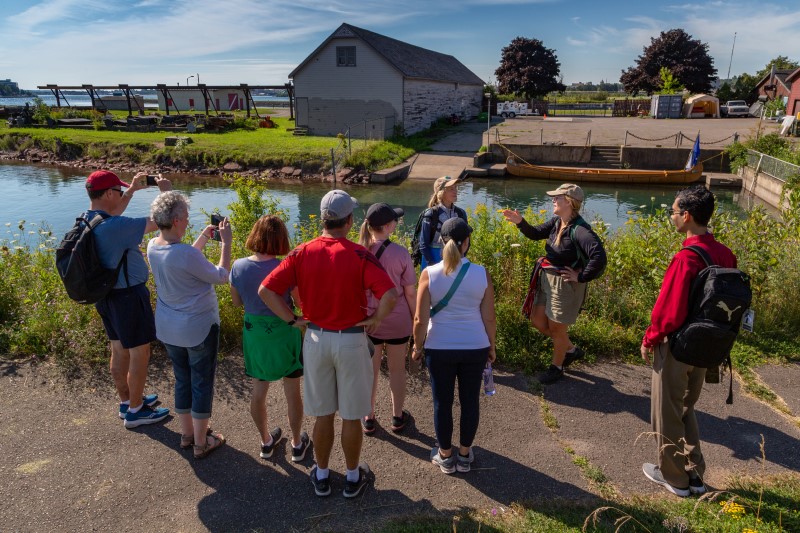
Outside, we see a re-creation of the rudimentary locks the voyageurs used to shuttle their Big Canoes around the Whitefish Rapids. Nearby, the weekly Mill Market hosts local food vendors and artisans where a Hudson’s Bay Company Post once stood.
As we walk, McGuffin tells me about the hidden river, where Fort Creek flows unseen beneath the city. She relates how downtown Sault Ste. Marie, from Bay Street to the river, is built entirely on reclaimed shoreline. “It’s not just about what we can see, it’s also what we can’t see,” she says. “When we don’t look at where water comes from and where it goes, we feel no responsibility for what happens along its journey.”
Before returning to the Métis Cultural Centre, we pause at the mouth of Fort Creek, marveling at the resilience and tenacity of water. The story of a people can be like a river that way—sometimes unseen, but always flowing steady and strong.
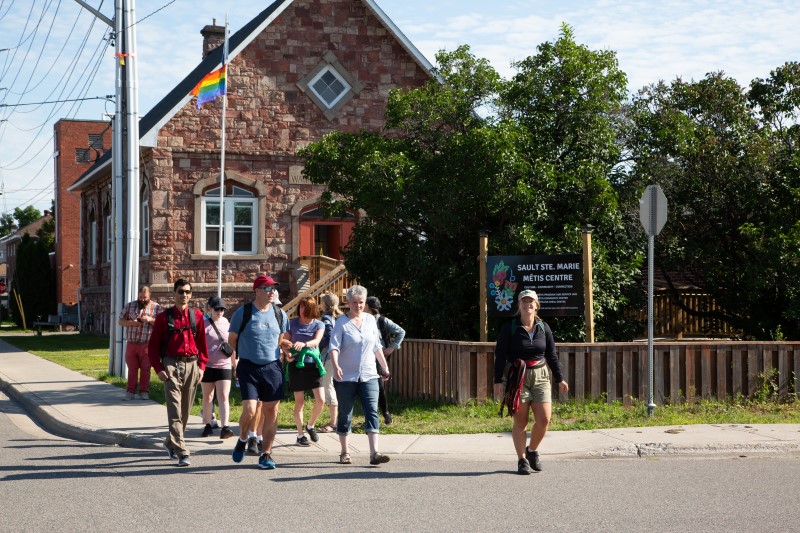
Guided Walking
Friday and Saturday mornings at 10:30 a.m.
Available late June–late September
Tours are 2 hours/5 km in duration
Cost is $50/adult or $25/student, group rate (max. 10 people) $350
Guided Walking & Paddling Tour
Thursday, Friday and Saturday evenings at 5 p.m.
Available late June–late September
Tours are 2 hours/7 km in duration
Cost is $90/adult or $45/student, group rate (max. 12 people) $675
All paddling safety equipment is included
Online Reservations
Individual and group reservations available. Learn more and book your tour now at Métis Tours.
Celebrate the 20th anniversary of the Supreme Court decision acknowledging the Metis Nation as a distinct Indigenous culture in Canada with a visit to the newly opened Métis Cultural Centre at 136 John Street.
The Sault Ste. Marie Museum, located in the heart of downtown, houses a fascinating collection of historical exhibits that helps visitors learn about the history of the city all the way back to its earliest days. Check out the Edmund Fitzgerald display in the Marine Gallery, which includes a replica scale model of the famous ship. View historic photographs to see what our waterfront and downtown used to look like, and enjoy some of local sport history including the Soo Greyhounds!
The Sault Ste. Marie Museum though is not just a space curated to tell the history of the local area, it also hosts many fun and unique events, publishes a weekly podcast series, contains a gift shop, and has a new interactive feature utilizing QR codes, which adds video and audio information to many of the displays. Come for a visit when you are in the Soo!
The Sault Ste. Marie Museum is a heritage building constructed originally as a post office between 1904-1906 after the city received $20,000 in funding from the Dominion Government. Like many buildings in Sault Ste. Marie it used sandstone excavated during the construction of the canal, with the iconic clock tower being added in 1912. At this point the Museum, then the Post Office was the largest and grandest building in the City and became a local landmark, being the first sight of the city for approaching travelers.
Today visitors can enjoy the typically Ontarian eclectic architecture combining several styles including uniquely cut stone walls, Romanesque arched windows, magnificent oak stair case and an exquisite three-storey skylight, and the 110 year old clock tower remains an iconic landmark of downtown Sault Ste. Marie.
The Skylight Gallery, on the second floor, is a walkthrough history and the story of Sault Ste. Marie from its early beginnings to the present day. Displays feature artifacts and information on the first people in the area with a full sized Wigwam and early canoe offering fascinating insight into historic life. Other displays feature information on the local fur trade, mining and the lumber trade, which as the displays tells, in 1810 became the main export from Canada.
Moving into the twentieth century the museum has exhibits on healthcare including nursing as well as policing and fire management. Additional information including archived video and audio is available via a series of QR codes, including the one below, which adds an interactive component to any visit of the Sault Museum.
The Discovery Gallery is a fun and interactive, hands-on learning children’s area. It contains artifacts and features nature species, photographs as well as a dress-up area. This space is also used to host workshops, activities and events, more of which is mentioned later in this article.
On the third floor is the Music Gallery, which showcases Sault Ste. Marie musicians and venues through the ages. Bands and musical groups originated at the turn of last century during the days of silent movies, and Sault Ste. Marie had its fair share of entertainers. Sounds from these bands would commonly be heard emerging from the Algoma Theatre, Grand Opera House and the St. Marys River Boat Club. During the 1950s and 1960s when smaller Rock & Roll bands became fashionable, musical acts would perform in local Sault Ste. Marie bars including the Victoria House, The Royal, Lock City Hotel and more.
The Music Gallery houses a collection memorabilia, artifacts and videos from these eras and also contains ‘The Sault Music Project’, a giant binder of past and present Soo musicians!
The Marine Gallery offers a pictorial display of early Great Lakes cruise ships, a brief history of the Locks and scale models of two of the more storied Great Lakes ships, the Edmund Fitzgerald and the Chicora.
The Chicora was a British blockade-runner for the Confederate Army during the American Civil War. Her role was primarily to transport guns and ammunition from Bermuda to Charleston. After the war, the ship was transformed into an overnight passenger and freight vessel, and carried mail and passengers from Collingwood to Sault Ste. Marie. In 1870, the Chicora was again involved in a dispute with America when she was refused entry to the American locks and was forced to unload its army destined for the Red River Rebellion. This particular incident, as well as a general tension between the two countries, spurred the building of a Canadian canal in Sault Ste. Marie.
The Edmund Fitzgerald is perhaps the most famous ship to be associated with the Great Lakes, having sunk in a November storm in 1975 killing the entire crew of twenty-nine. A scale model, as well as information about the ship’s fateful timeline, can be viewed in the Marine Gallery of The Sault Museum.
The Sports Hall of Fame gallery depicts local athleticism from the 1800s forward and features artifacts and photos showcasing the wide variety of sports that represent our city. Check out the Eliason Motor Toboggan, and a special commemorative display for the 1948 NOHA champions, the Soo Greyhounds!
A video presentation highlights various sports and the people involved. The gallery is dedicated to Russell H. Ramsay, local sportscaster, president & general manager of Hyland Radio & TV. He served as an Alderman on city council and served as the MPP for Sault Ste. Marie 1978-1985.
This gallery, on the first floor, is dedicated to Lt. Col. Walter Wallace, past commanding officer of the 49th Field Regiment RCA, past president of Royal Canadian Legion – Branch 25 – and past president of the Sault Ste. Marie & 49th Field Regiment RCA Historical Society. Walter was a big advocate for museum later serving as president of the board of directors. He helped oversee the move of the historical Society’s collection to the museum in 1983.
The museum’s wartime collection includes a selection of diaries from 1914 to 1918, military medals and badges, trench art, photographs, and uniforms among other items.
SURVEYOR’S STAKE DATE: 1846
The stake was used by local surveyor Alexander Vidal. The large square wooden post, pointed at both ends of the stake, features carved lettering on all four sides to depict the direction from the stake in which each divided land plot would begin. It was used to dictate plots and streets based on Vidal’s surveying.
COMMEMORATIVE KEYS DATE: OCTOBER 28, 1954 & NOVEMBER 7, 1963
These two commemorative keys were presented to the Grey Sisters of the Immaculate Conception during two significant ceremonies in Sault Ste. Marie. The keys celebrated the grand opening of the General Hospital’s addition of the New Pavilion’s B Wing in 1954 and the Pavilion’s A and Y wing in 1963.
Located inside is also a great gift shop, the Clock Tower Gift Shop, which contains unique books about the area, local art works, craft works by local consigners and various locally made gifts and goodies!
Every Thursday, the Sault Museum publishes a podcast under the series titled ‘Stories of Northern Life’. This unique and fascinating series covers local history, tells important local stories, and from time to time has a Q&A with Museum experts and staff, where often-wondered questions like ‘Is the museum haunted?’ are discussed.
The Sault Ste. Marie Museum runs many unique and fun events and activities each week. Whether it’s a Prohibition Event with beer tasting and trivia, Murder Mystery nights, Scottish Highland dancing or one of the various paint nights including ‘Bad Art Club’ and ‘Star Wars Paint Night’. All the information about the various events can be found here!
For more information about this wonderful collection of local history, visit the Sault Ste. Marie Museum’s website.
And did you know that you can pick up a 4-Culture Attraction Pass on the Sault Tourism website? This Pass will give you 10% off admission to the Sault Ste. Marie Museum as well as the Canadian Bushplane Heritage Centre, the Ermatinger Clergue National Historic Site and the Art Gallery of Algoma. Click here and scroll down the page to learn more. Plan your cultural visit in Sault Ste. Marie today!
By Diana Lee @only1phoenixx
Many of us that enjoy spending time in nature love learning more about the spaces we play in. Whether it’s learning about new paddling spots to launch from or about the wildlife we’ll see along the way, we outdoor enthusiasts typically want to get more out of our adventures!
When you go on an Indigenous-guided tour, be prepared to see, explore, and appreciate the lands and waters we play in from a different lens by recognizing and supporting Indigenous People’s deep connections with these spaces.
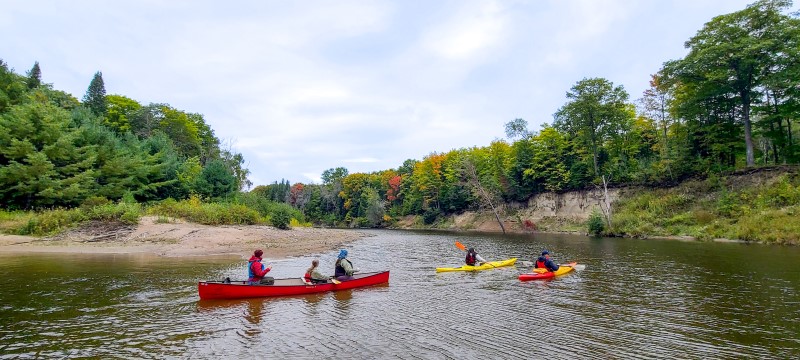
On a recent trip to Sault Ste. Marie in Algoma Country, home of the Anishinaabe since time immemorial, I spent some time with Thrive Tours, an Indigenous-owned and operated guided ecotourism company, and the experience went above and beyond a paddling tour.
As a non-Indigenous person, I’m always excited to learn more about our amazing province, country, and world. I’ve been lucky enough to join in on a few Indigenous travel adventures from Inuvik, Northwest Territories, to Puvirnituq, Quebec, and I’m happy to share a few highlights from my paddling trip and why you should plan your next adventure with an Indigenous-led tourism operator.
Whether you’re visiting Sault Ste. Marie (traditionally known as Baawaating), or a local, it’s always fun discovering new paddling spots in and around the city. As a stand-up paddleboarding (SUP) aficionado, I bring my paddleboard on all my road trips and travels. I was excited to learn I could BYO (bring your own) SUP for this Thrive Tours paddling adventure!
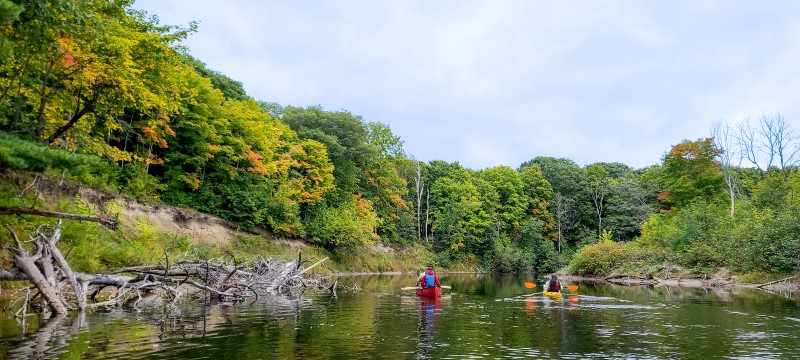
Our first stop was at Thrive Tours’ home base in the Soo, where I met the owners and operators, Amanda (Biimskoonkwaat) and Brad (Ozhaawashkwaa Animikii). Together, they adventure all year round, offering guided canoe, kayak, hiking, and snowshoeing while promoting and maintaining local Indigenous practices and philosophies.
After chatting about what we felt like doing – canoeing, kayaking, or stand-up paddleboarding (SUP), we packed up everything (yes, everything, haha!) We headed to Garden River, located in Garden River First Nation. I learned that this is a sacred area, and a guided tour is a great way to experience this waterway.
Before launching our boats and board, we began by offering Tobacco to the water, a sacred way to connect with all living things. Brad shared the importance of Semah, the Anishinaabemowin word for Tobacco, “when we place Tobacco in our left hand, it symbolizes the closeness of that medicine to our heart. When we transfer those good thoughts and meaningful intentions into the Semah and place it in the water, we connect with all our ancestors and creation itself.”
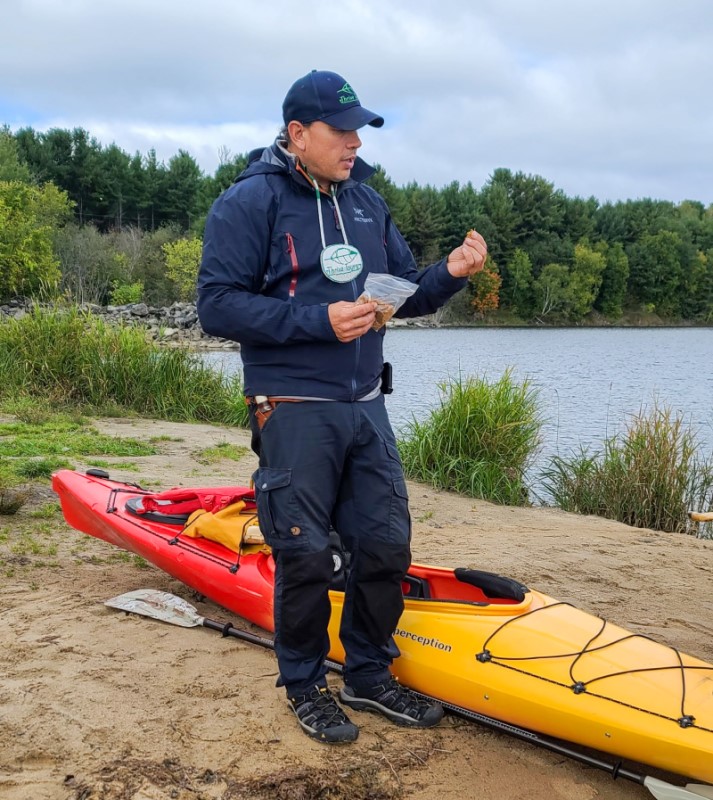
Seeing wildlife always sparks joy and the Thrive Tours team combined the sightings with Anishinaabe teachings right on the water. Seeing eagles, migizi in Anishinaabemowin, swooping down from the trees in front of us was incredibly special. Eagles also symbolize love, or zaagi’idiwin, as part of the 7 Grandfather teachings.
As we continued to paddle, the occasional splash of salmons jumping out of the water kept me excited about what we would see (and learn about) around the next bend of the meandering river.
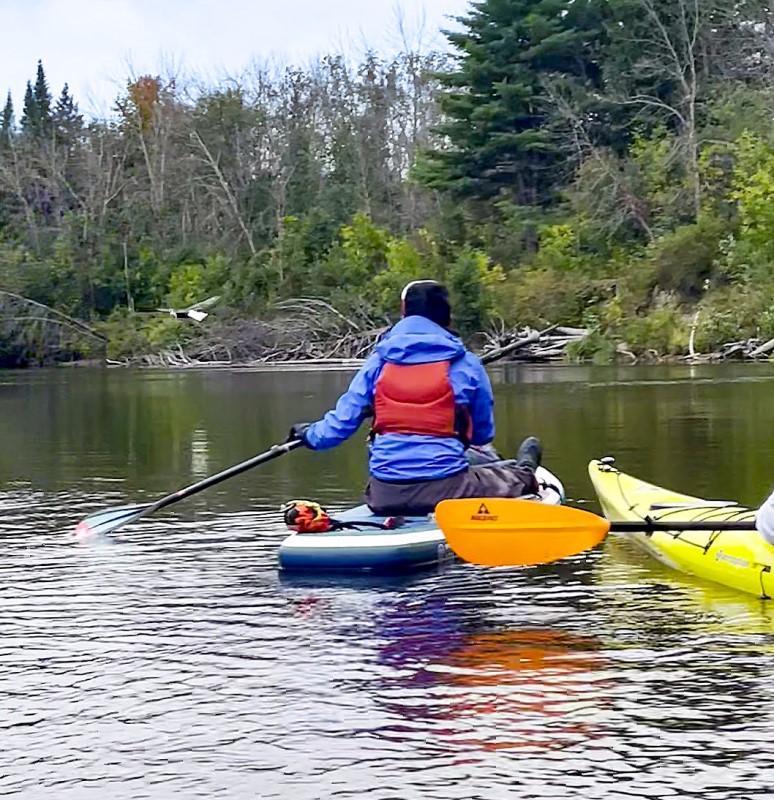
When it was time to take a break, we enjoyed warming up by a mini campfire, with snacks and great conversations while sipping warm Cedar Tea.
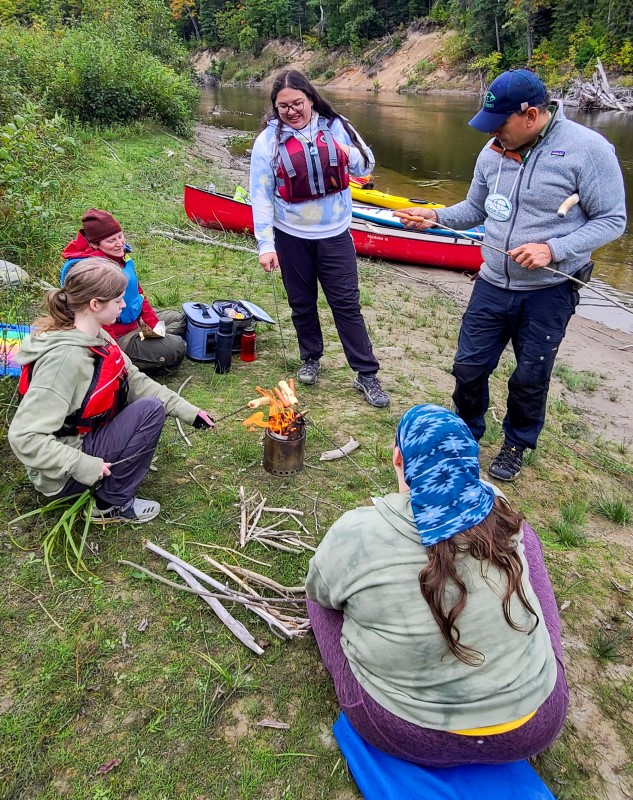
During this tour, I got to chat with Lucia Laford, a local Indigenous artist, educator and one of the Thrive Tour guides. Lucia leads a Paddle & Paint Woodland-style painting workshop where participants can create their own nature-inspired painting while out in nature! Lucia also teaches Anishinaabe Art and Material Practices at Algoma University.
“Woodland style is about visualizing the connection and relationships between people, animals, spirits, and nature. I paint my way of life, the Anishinaabe way, which includes ceremony and spirituality, but also my connection to the land and the plant, tree, and animal nations. In this way, my work is completely inspired by nature and the love and respect I feel towards Aki (the earth), Nibi (the water) and all things in creation.
The Paint & Paddle workshop is about connecting with yourself on the water and the land. Woodland art helps deepen that connection by exploring the relationships and personal kinship we have to life around us. We [Thrive Tours] helps facilitate the joy of being on the land and water, and we do so in a safe, respectful, and sustainable way. When paddling, we talk about the concepts in Woodland-style art while sharing Indigenous perspectives and teachings. Paddling and being able to touch the water and land that we are talking about serves as an incredible inspiration when painting!”
– Lucia Laford, Thrive Tour Guide, Woodland style painter and Indigenous Arts educator
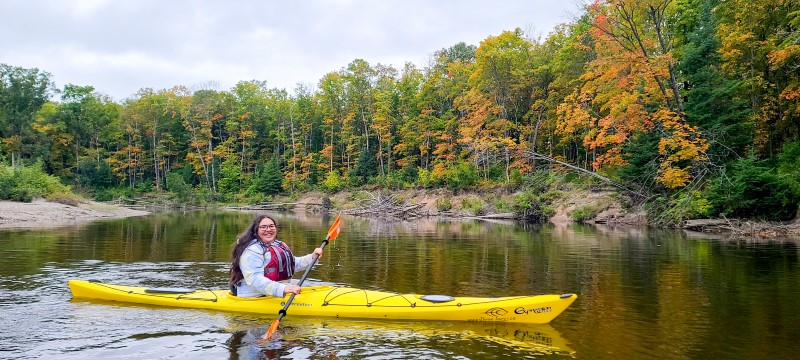
For many Indigenous People, music was a way of storing ecological, ancestral, and traditional knowledge and teachings. Passing along that knowledge was often done through stories and songs.
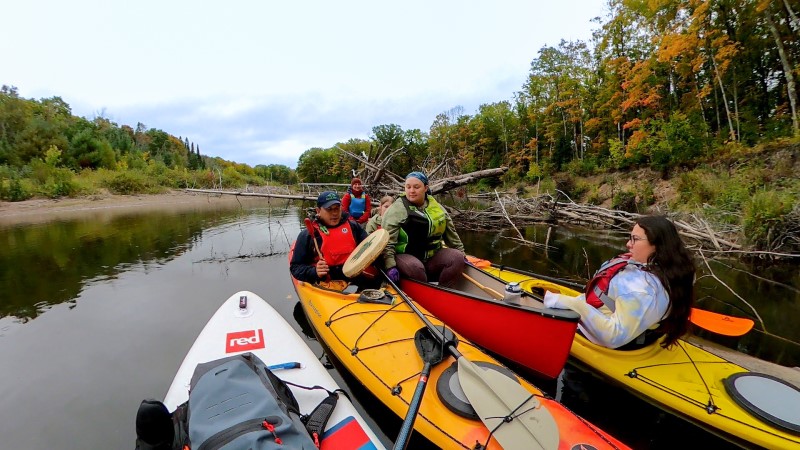
The gentle current carried us along the river while Amanda and Brad, a powwow singer and member of the Black Bull Moose Singers, shared a few honour songs for women and all of creation. Lucia also shared a Water Song*. The lyrics and varied tempo beautifully represent and honour water – from fast-moving rapids to the steady slow flow of a river, like the Garden River we were floating along. We were all invited to sing along and celebrate being on the water.
While I had no expectations for the tour and was open to going with the flow of Thrive Tours, the way we concluded our paddling adventure was incredibly moving. When I asked if they do this for every tour, Amanda explained, “while every experience [with Thrive Tours] unfolds uniquely, we consistently incorporate physical, emotional, mental, and spiritual aspects. Every adventure includes cultural teachings, Indigenous food sharing, nature-based activities, and First Nations ceremonies.”
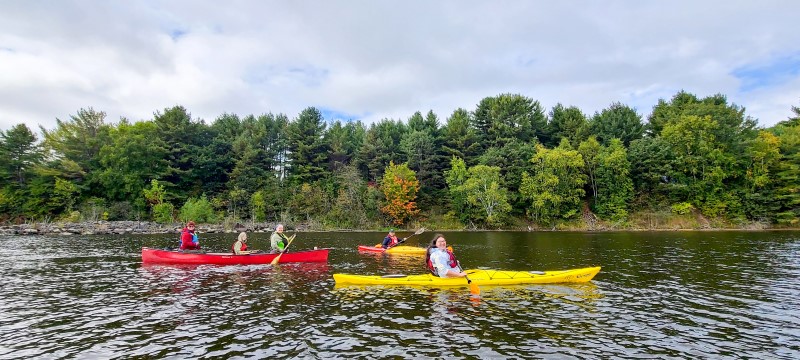
Authentic Indigenous-led travel experiences can help share the stories, histories, and perspectives we don’t get to hear more often. What we can do as allies is to help support that by taking these tours and being open to learning. These excursions that combine outdoor recreation with learning education alongside an Indigenous guide lead to more consideration, respectful, responsible, and meaningful future adventures, whether we travel solo or with company. Travel experiences like this are a step towards taking us beyond land acknowledgements through active participation and ongoing learning, all while adventuring in the spirit and continuous practice of reconciliation.
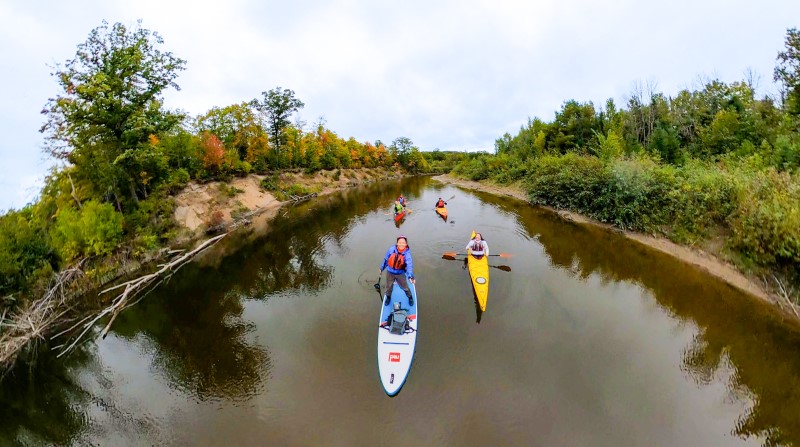
Thank you, Amanda, Brad, and Lucia, for the unforgettable time in Sault Ste. Marie. I look forward to seeing you again soon (hopefully in winter, my favourite season!)
Thrive Tours
https://www.thrivetours.ca/about
For more Indigenous-owned or led travel and adventure ideas:
Recommended resources and further reading:
Diana Lee lives for adventure, the great outdoors, and stand-up paddleboarding (SUP)! She is a certified ISA SUP Instructor, a librarian, and a reporter for Get Out There Magazine. Find out what she’SUP to @only1phoenixx on Instagram and Twitter.
Are you interested in going to a powwow but not sure about going on your own? Thrive Tours, an Indigenous-owned and operated guide company, offers Learn to Powwow Tours in the Sault Ste. Marie area. These tours introduce non-Indigenous tourists to powwows and will teach you everything you need to know.
Our family was able to join Brad and Amanda, owners of Thrive Tours, on a Learn to Powwow Tour and had an incredible experience together! Our tour group included Sault Ste. Marie locals, Ontario tourists and travelers from around the world. We came together as a group of all ages to learn to powwow and experience a celebration of Indigenous culture.
Our tour began with an introduction to powwow history, tradition and etiquette. Our guides taught us the cleansing practice of smudging and invited us to participate in this traditional ceremony. Along with our guides, we also had special guests from the Indigenous community come and speak to us.
When settlers came in, the local Indigenous people were no longer allowed to practice their culture. The sacred ceremonies and songs had to continue deep in the bush and underground. Despite this oppression, the tradition and the heartbeat of the drum carried on and continues today. Although often looked on as traditions of the past, Brad shared with us that they “are not people of the past, but people with a past. [We] have an amazing history and an amazing future!”
During our introduction we were also honoured to have Chief Dean Sayers of Batchewana First Nations come and speak with us. He shared some of the history of the Indigenous people of the Sault Ste Marie area, also referred to as Bawating, meaning ‘place of the rapids’. Chief Sayers welcomed us to come on in and celebrate!
Lucia, who has been dancing at powwows since she was a young girl, shared with us the dos and don’ts of the powwow. She told us that it is customary to stand at the beginning of the powwow, as a sign of honour, while the dancers enter the circle during the Grand Entry. Taking photos and videos during the Grand Entry is not allowed, but Lucia shared with us the proper way to take photos at other points during the powwow.
Our guides explained to us the different types of powwow dancing and the significance of the dancers’ attire, called regalia. Our guide Brad is a powwow singer and drummer who has been powwowing for about 15 years. He shared with us the history and significance of drumming and how the beat of the drums honors the heartbeat of Mother Earth.
After our time of learning we went as a group to the powwow. On our way to the circle we passed by the sacred fire. This fire is lit before the powwow starts and burns until the end. Fire keepers sit around the fire to make sure it continues burning. We honored them and the fire by putting tobacco in the fire and saying ‘Miigwetch’, which means ‘thank you’.
The powwow we attended, Gathering at the Rapids at Algoma University, was an indoor Competition Powwow (differing from a Traditional Powwow). There were a number of drum groups and dancers of all ages competing in different categories. As we entered the building, the Grand Entry was underway. We could feel the heartbeat of the drums resonate within us and stood as the dancers entered the circle. The intricate designs of the dancers’ regalia was amazing to see – bright colours, feathers, tassels, beading and jingling cones. After representatives carried in flags and veterans were honoured, the competition began.
We listened and watched as different drum groups took turns singing and drumming while the dancers made their way around the circle. We saw different categories of dances – traditional, jingle, grass, fancy – and watched as each age category took their turn, from the tiny tots to the golden age dancers. Our guides were available throughout the powwow to answer any questions we had and shared more information with us about the different dances.
One unique experience that we had not been expecting, was the opportunity to join in on the dancing! Throughout the powwow there are inter tribal dances, where everyone from every background is invited to come into the circle and dance. Our children have been learning about Indigenous culture and powwows in school and to actually be there and take part was a very special experience.
In addition to the drumming and dancing, there were also Indigenous vendors set up at the powwow. We admired the handmade goods, enjoyed some lemonade and ate delicious food!
As a non-Indigenous person, I’ve been hesitant about attending a powwow in the past. I didn’t know what the proper etiquette was and didn’t want to be disrespectful in any way. It was so great having our guides from Thrive Tours to show us around and answer all of our questions! The whole powwow environment was one of total inclusivity, positive energy and people coming together to celebrate!
There are several Powwows during spring and summer in and around Sault Ste. Marie, and if you are interested in going you’ll definitely want to check out Thrive Tours’ Learn to Powwow Tours. Learn about the history, people, food and traditions; dancers, drums, singers and teachings. Half or full day experiences are available. Contact Thrive Tours for more info.
And read our other blog post from summer 2022 about spending a day exploring Indigenous culture with the family in Sault Ste. Marie here!
By Gabriela (gabynocanada.com)
We are crossing Canada this summer and we had to include Sault Ste. Marie in our itinerary. We were impressed with the city when we visited Northern Ontario last year (see details here). But this time we decided to do something different: we explored the beaches around the city. Sault Ste. Marie is a super green city and full of parks and beautiful beaches around it, so this time we decided to visit some of these places and in this post. I will bring a list of 3 beaches that we visited in the region and that we recommend for everyone.
I think it’s important to highlight that not all the beaches you visit here in Canada are the way we are used to in Brazil: with sand, shallow water and easy access. Some beaches have rocks instead of sand (i.e. it is very difficult to walk), others have very rough water and some have difficult access… Some of those beaches are not suitable for families with children. The 3 beaches we visited in Sault Ste. Marie are family friendly, so it’s worth highlighting this here before writing about them below.
Harmony Beach is located in the Haviland Bay, and is the first beach you will come across when traveling north from Sault Ste. Marie via the Trans Canada Highway along the shore of Lake Superior. This public beach is the favorite of people that live in the region (and was crowded when visited). The place is just a half hour drive from Sault Ste. Marie, so if you’re in town and want to get a taste of Lake Superior beaches this might be an option. The beach has 3.2 km of sand and is considered a great place for swimming.
This provincial park is a day use park only, which means it does not have camping sites and you cannot spend the night there (click here for more details). Even so, it is VERY worth the visit, being only 50 minutes north of Sault Ste Marie. The park has several picnic tables on the beach and also restrooms, so I liked the fact that it had this structure (which helps a lot when visiting with children) but looks very remote. The sandy beach is 5km long and the water in this bay is shallow, which makes it warmer.
This provincial park is just 1 hour north of Sault Ste Marie and 10 minutes from Batchawana Bay Provincial Park (the drive is beautiful so you won’t even notice that 1 hour go by). This park is super popular with its 3km beach, a beautiful 3.5km trail (Edmund Fitzgerald Lookout hiking trail where you can have a panoramic view of the entire region), the super blue Caribbean style water and 476 campsites. By the way, the camping sites are close to the beach so if you camp this would be a very special place to spend the weekend. Click here to learn more about the location.
The beaches are just one stop of many on the beautiful Lake Superior coastal drive.
The Edmund Fitzgerald Lookout Trail in Pancake Bay Provincial Park offers a beautiful view across a luscious maple forest all the way to the big lake. You may also see the final resting place of the Edmund Fitzgerald ship.
A little further north of Pancake Bay is the Lake Superior Provincial Park, which includes the Agawa Bay visitor centre. Read all about this area here!
Beautiful souvenirs and ice-cream treats are available at Agawa Crafts and the Canadian Carver further south and The Voyageur Lodge also has some great souvenirs and food options. Chippewa Falls, the famed halfway point on the trans-Canada highway is a great spot for a break. The falls are right beside parking lot, just off the highway. Check out another Group of Seven art easel while you are there.
I hope you enjoyed this post and if you can, visit this region of Ontario: beautiful and relatively close to Toronto. For more information about Sault Ste Marie visit the Sault Ste. Marie Tourism website.
By Sault Tourism and Canadian Cycling Magazine
Canadian Cycling Magazine and Charlotte Batty from Minii Adventures spent a couple of days checking out our new trails, because we think that Sault Ste. Marie is the perfect place to spend a weekend mountain biking! So check out this awesome video above by Canadian Cycling Magazine, then continue reading below, and finally, start planning your awesome adventure here in the Soo!
Sault Ste. Marie has some of the best mountain bike trails in Ontario, and we’ll talk more about them in a second, but did you know that these trails are just ten minutes from downtown? So you can be riding hard one minute then relaxing at a microbrewery almost the next. This combination of awesome trails and close proximity to the city is what makes Sault Ste. Marie the perfect mountain biking destination.
We recommend you start your mountain biking adventure on the newly constructed Farmer Lake trail (trail forks map here). It’s a 7 km out and back trail through the stunning Canadian Shield that will eventually take you to the beautiful Farmer Lake. Before you get there you are going to have to navigate up the rocky Climb to Canyon section, a new modern flow XC trail that is a fun test of your technical skills. With your heart pumping hard from climbing the almost 50 m hill you’ll then be met by the many berms and hairpin turns of Farmer Lake trail. Finally, you’ll descend to reach the beautiful oasis that is lake the trail is named after.
On the way back advanced riders may want to test their skills with on the new Crazy Train trail; an adventurous and aptly named downhill trail which has enough vertical to keep any adrenalin junky interested.
Catch your breath after that, but not for long because the end of the Farmer Lake system is one of the jumping on points for the popular Crystal System (trail forks map here). The Crystal is what everyone is talking about up here in the Soo; we added 12 km of new machine built flow trails here last year bringing the total to over 20. You can ride alongside (and over) beautiful creeks, take in some spectacular lookouts, or simply enjoy the rollercoaster experience of new flow trails such as Berm Baby Berm.
The Crystal really has something for every ability, and with so many trails and combinations of trails, you can easily spent a day here alone.
The Farmer Lake and Crystal systems make up just over half of the trails at Hiawatha Highlands, with the Pinder and Red Pine System completing the list (trails forks link to Pinder and Red Pine). The Pinder has roughly 8 km of green rated single track, so it’s perfect for beginners or families with young riders. Then there’s the Red Pine system, which at 15 km long, is a bit tougher with more elevation, but still has a wide array of trails. The Red Pine is a combination of blue / black trails and great diversity of single track trails, transporting you from the historic beginning of MTB to new modern hand-built fun-flow trails like Stickman.
There’s only so many mountain bike trails a regular person can ride and after a day and a half at Hiawatha, you may feel like cranking the pace down a touch. If so, the Hub Trail could be the perfect ride for you. It’s a 22.5 km easy loop of the city where you can ride at your leisure and soak up the sights. You’ll pass some of the well-known tourist spots like Fort Creek, the famous locks between Lake Superior and Lake Huron and the beautiful St. Marys River waterfront.
The Fort Creek Conservation area is a beautiful spot with three bridges giving you incredible views of the creek and surrounding forests. Continue south through the city to the Canal District and Machine Shop area. This area has been restored from a previous industrial area to become one of the hottest parts in town for great food and drinks. Delicious pizzerias, cozy pubs or fine dining can all be found in one centralized area. The vibe of the Canal District is warm and inviting and perfect after a day of riding.
Take a side-trip along Whitefish Island’s boardwalks and trails where you will get a spectacular view of the international bridge as well as the famous Sault Ste. Marie rapids.
Back on the Hub Trail and riding along the waterfront you might notice some of the many pubs and restaurants in the area. Fluid Restaurant has great food as well as beautiful views of the rivers. At the Bondar Pavilion you can hop on a 2-hour river cruise of the newly launched Miss Marie Sault Locks boat. Or if you’d like to enjoy the waterfront a different way, visit the Waterfront Adventure Centre. The WAC rents canoe, kayaks and SUPs; great for exploring the waterfront.
By now though you may be craving some great post-ride hydration, and the Soo has a great pick of watering holes. Outspoken Brewing and Northern Superior’s Tap Room are great microbreweries if you’re looking to try some local suds. Both often have local bands playing and the vibe is great!
So consider a mountain biking trip to Sault Ste Marie. Come with friends, come with family, come by yourself. Ride our awesome new trails and stick around after and check out the sites of the city!
Thanks again to Canadian Cycling Magazine and Charlotte Batty from Minii Adventures!